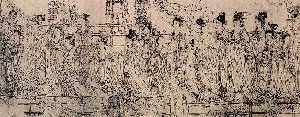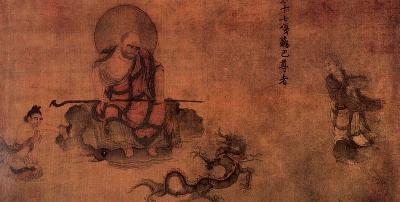| Art Q&A > Painting |
|
|
Wu Daozi, Sage in Chinese Painting
Wu's most prolific period was during the Kaiyuan and Tianbao eras (713-755) in the Tang Dynasty. Born in Yangzhai (Yu County in Henan Province), Wu lost both his parents at a young age and lived a hard life in his early years. He learned how to make a living from folk artists and sculptors. Because Wu studied hard and was talented in art, he earned himself a good reputation as a painter by the time he was 20 years old. Emperor Xuanzong invited Wu as an imperial painter in the court, naming him Daoxuan. As an imperial painter, Wu only painted at the emperor's request, which was a big restriction for a civilian painter. On the other hand, the court provided the best living conditions and was an outlet for artistic creativity.
Wu mainly created religious murals all his life and his abundant works had a wide range of subjects. According to records, Wu painted over 300 murals and more than 100 scrolls. While many of them involved Buddhism and Taoism, Wu also drew mountains, rivers, flowers and birds. The Presentation of Buddha is his most representative work. Unlike his predecessor Gu Kaizhi, whose line strokes were slender and forceful but lacked variety, Wu's strokes were full of change and vigor, expressing the internal world of his subjects. Wu was always in great ferment when he was painting, and his works exhibit an expressionist style. |
||||
All rights reserved. Reproduction of text for non-commercial purposes is permitted provided that both the source and author are acknowledged and a notifying email is sent to us. |
||||
 |

